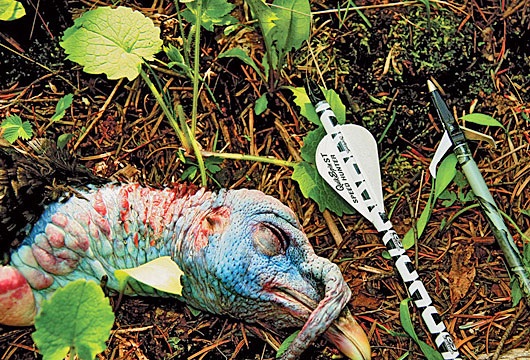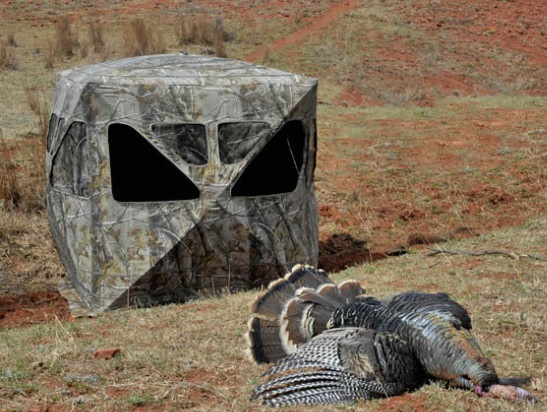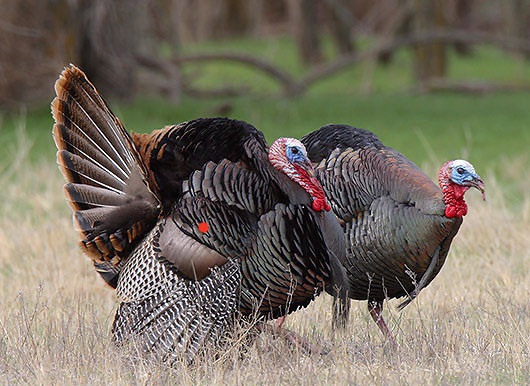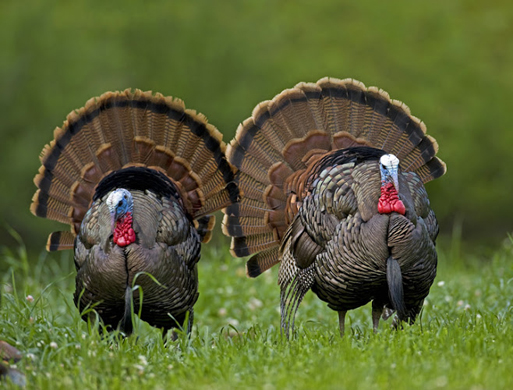LAST UPDATED: May 1st, 2015
Harvesting a wild turkey with a bow can be one of the most challenging endeavors archery hunters can pursue. A successful turkey hunt is comprised of many variables, many of which the hunter has little control over. However, there are steps you can take to ensure you will be ready when the moment arrives to send an arrow through a gobbler this spring. Here are a few tactics that will help you add another set of spurs to the trophy room.
Taking a mature spring gobbler with a bow can be extremely tough but very rewarding.
Fool the Eyes to Win the Prize
Wild turkeys can see ten times better than humans; which makes their sense of sight the best defense mechanism they possess. Today’s camouflage patterns are only getting better but the most important aspect of staying concealed is making sure you have the appropriate surroundings. The majority of failed attempts to harvest game within in shooting range is due to hunter movement.
One of the best methods for bowhunting longbeards is to utilize a pop-up style ground blind. This is the most effective weapon in the bowhunters arsenal for eliminating much of the gobbler’s ability to see you move. Although ground blinds do not conceal all movement they do however provide the hunter with the ability to move into position and get drawn back for a shot. My goal for spring turkey season is to have a blind located near a roosting area that I know the birds love to utilize after they fly down. If you are going to hunt from a ground blind try to wear a black top with a black beanie or hat. Facepaint or a mask is also another great option. This will help you blend in with the darkness of the groundblind. However, make sure you bring a camouflage shirt or jacket with you in case you have to change locations where a groundblind cannot be utilized.
Ground blinds can be very productive when bowhunting longbeards.
Often throughout spring turkey season you have to be mobile with the birds. This makes the use of a groundblind very difficult. This type of approach to bowhunting turkeys is where you must create concealment within your surroundings. Personally, I try to position myself in thick areas of brush or trees if available. I also try to position myself out of line with where I feel the birds will be approaching. This keeps the birds focused on the decoys and not on me as I draw for a shot.
Essential Gear for Gobblers
Gear for bowhunting turkeys needs to be simple. The less you have moving the better chance you have of capitalizing on a hard to get opportunity. Keep your bow setup simple. The number one mistake I see in a hunter’s setup for bowhunting turkeys is the draw weight. You must be able to draw your bow straight back without much effort. This will eliminate an extreme amount of movement. I also try to shoot without my quiver attached which cuts down on moving parts and extra gear for the turkey to notice.
Turkey hunters have their favorite calls. For instance, I love a good slate call but unless you have a designated caller your best option when bowhunting turkeys is to master the mouth call. How often have we had our bow at the ready and our release clipped on the string only to realize we need to grab our grunt or bleat call to turn a big buck? Normally we can pull that maneuver off without a hitch, but try reaching for a slate or box call with a turkey in sight. This can result in disaster.
The author loves using a slate call for spring turkeys but often relies on a mouth diaphragm call when bowhunting for beards.
Decoys can be a beard chasers best friend or his worst enemy. The majority of turkeys respond well to decoys but there are a few that remain cautious and hang up just out of range. I normally elect to utilize a decoy and often a hen and gobbler combo. The use of decoys provides the hunter with two very important ingredients. Decoys tend to keep the birds focus away from the hunter, which improves the chance for a shot opportunity. However, decoys also provide a solid yardage marker. Many bowhunters elect to place their decoys at the 20-yard mark. This works well but will often result in a 22 to 25 yard shot opportunity. I personally place my decoys at 15 to 18 yards depending on the surroundings. This normally places the bird at or under the 20-yard mark making for an easy shot.
Accuracy is King of the Spring
Archery hunters know how important accuracy can be when hunting any type of game animal. Turkeys are no exception. Practice before turkey season is a must and will give you the added confidence when the moment arrives to connect on a spring gobbler. I change my practice habits slightly this time of year. The first thing I do is practice every shot sitting or kneeling because I know all of my opportunities will be from this type of position. Secondly, I shoot for much smaller targets such as dime size circles. This helps me focus quickly on a small kill zone which turkeys have. My final step is to practice from a groundblind or concealed area of the woods. This provides you with a scenario much like you will encounter in the field when that old tom comes strutting in.
Shot Placement
One thing we must understand when bowhunting turkey is where our shots should be placed. There are a few different shot opportunities a gobbler can present. The most desired shot would be directly above his legs or thighs. This will do two things; first it will break the turkey down by severing tendons that operate the birds legs. Secondly your arrow should pass through the turkeys vitals making for a quick harvest. Headshots are an option but leave little room for error even with broadheads designed for harvesting turkeys. You may also aim just under the butt area of the wing, which will result in a lethal shot.
This picture shows the desired shot opportunities for arrow placement on a gobbler.
Scouting
Scouting for turkey is also a critical element in your ability to harvest a spring time gobbler with your stick and string. There are a few key things to look for when out on your scouting mission. First, I like to start by glassing fields in the early morning hours when birds tend to feed in open areas. This can provide a wealth of information. Often times you can gain an understanding of where the birds may be roosting as well as their travel route to feed. Also you can see the number of birds in each group which can give you an idea of how many eyes you may encounter during a hunt, not to mention you get a great look at the gobblers you may want to pursue.
If fields or open areas are not an option for you then you have to move to stealth mode. Sneak into areas where you feel birds tend to feed or move. Many times you can narrow these locations down by looking at the trees in an area. I know the birds in the south where I spend the majority of turkey season love to roost in large live oaks. When in areas you know turkey frequent look for dusting areas, trails to food sources and possible areas where turkeys may spend time during the day.
This is a great place to utilize trail cameras, which will help you pattern birds throughout the season. Keep an eye out for droppings as well. This can often times be found at or near a roosting area. The final step in the scouting process is narrowing down where the birds roost. Spend time late in the evening listening for birds to fly to roost and then structure your gameplan around where you know they like to frequent at first light.
Strutting gobblers can make even the seasoned turkey hunter’s heart pound with excitement.
Quick Tips for Tricking ole Tom
I have always felt turkey hunting was much like elk hunting. The setup is very similar. Here are a few closing tips for bowhunting spring gobblers.
- Positioning yourself out of the bird’s line of sight upon approach will be the key in your ability to harvest birds with a bow.
- If you are hunting with a partner always make sure the caller is behind you and on the side relative to the decoys.
- Do not be afraid to have the caller drop back 30 to 50 yards to coax in a wary gobbler. Often times mature birds hang up and will not commit unless they feel the hen is leaving.
- Wear gloves, facepaint/facemask, hat, and appropriate camouflage for your surroundings. Blend in.
- When calling to a bird do not be afraid to sound like a bird. Scratch the ground, move leaves to imitate a feeding hen.
- Stay patient. Many times turkeys move slowly and take time to commit. Do not over call once a turkey is committed.
- Check all turkey hunting regulations for your area.
Hopefully you are prepared for the spring turkey-hunting season. Bowhunting turkeys can be a very rewarding and challenging. The most important aspect is to be safe and if you get a chance take a first time turkey hunter with you on your adventure. They will thank you and be forever hooked once a big tom comes strutting in.










